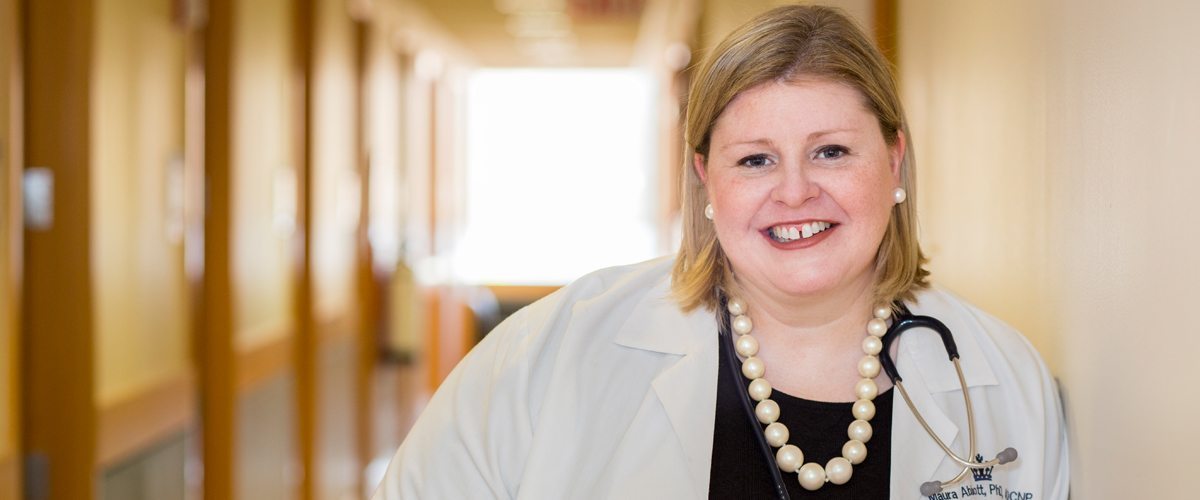Beyond the Bandage: Maura Abbott
The nurse-patient bond is as crucial to quality healthcare as it is to hope.


For Steven Golden, there is something special about running into Maura Abbott, a nurse practitioner, when visiting his doctor at NewYork-Presbyterian/Columbia University Medical Center.
“She can be walking with a crowd of colleagues and the minute we spot each other, she leaves them to come and see me,” he says of Abbott, the nurse practitioner who once oversaw his care. “She always takes the time to sit down and talk with me.”
Steven met Abbott in 2014 when he enrolled in a clinical trial for which Abbott was a part of the care team. Their interactions marked the first time since his 2008 diagnosis that Steven and his wife and advocate/caregiver, Marilyn, felt like they had a true partner in their cancer journey.
“Maura gave us her home number and email and made us feel like we could contact her anytime with questions—and we did,” he says.
Since their first interaction, Steven and Marilyn have exchanged countless emails with Abbott and spent untold hours discussing lab results, treatment protocols, and medical studies on the phone and in the clinic.
“There’s a lot of fear associated with what you’re dealing with,” says Steven. “[Maura] knows how to make us feel comfortable. She is experienced, she knows what she’s talking about … and there’s a sense of trust, and we trust her.”
Abbott joined the hematology/oncology department at NewYork-Presbyterian/Columbia University Medical Center the same year she met Steven. She believes that taking a hands-on approach to care is an essential part of her role as a nurse practitioner.
“Our patients are more than a medication dose or a lab value on a piece of paper, and nurses are more than needles and stethoscopes,” she says. “We form close bonds with all of our patients and almost become like families.”
Abbott believes these nurse-patient bonds are unique in a healthcare setting.
“Our patients are more than a medication dose or a lab value on a piece of paper, and nurses are more than needles and stethoscopes.”— Maura Abbott
“The bedside nurse is there for 12 hours per day,” she says, “so we get to know our patients differently because we’re spending so much time with them.”
In all stages of cancer treatment, Abbott believes that nurses provide a critical combination of medicine and friendship. As part of the oncology care team treating Steven, she learned about his life outside of the hospital, including his grandchildren, his company, and his passion for art and travel.
“Steven always says I don’t just treat him like a patient, I treat him like a person, and I always stop to listen to him,” she says. “I think about the cancer as just a small part of his life.”
Even though Abbott is no longer treating Steven—she accepted a position as an assistant professor at Columbia University’s School of Nursing in addition to her role as a nurse practitioner—she stays abreast of his treatment and continues communicating with both Steven and Marilyn whenever they have questions.
“Knowing she has stayed aware of the specifics of my case is really special,” Steven says. “It confirmed to me that she hasn’t forgotten me and moved on, that she is really invested in my care.”
Marilyn believes longer, patient-centered conversations and ongoing hand-holding are areas where nurses excel.
“There was somebody who was willing to take the time … and focus on us,” Marilyn says. “There was not a feeling that she’s got to rush out of the room or she’s got another patient to see; to me that was very important.”
Abbott believes nurses have roles beyond helping patients beat cancer.
“The care we provide helps patients get to weddings, birthday parties, and graduations,” she says. “These connections mean everything to nurses and patients. It leads to better care.”

